The best pencils for marking on dark wood
Testing four options for making marks stand out on the darkest of woods.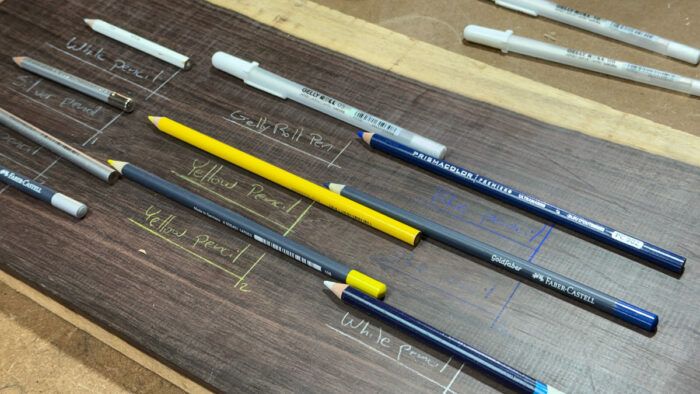
I’ve found myself with a big old board of katolox wood on my bench. Sometimes referred to as Mexican ebony, it’s a very dark wood with almost a deep purple hue. As I started to plan how to get my parts out of the board, I was suddenly reminded how difficult it is to see your markings on dark woods like walnut, rosewood, ebony, and now katolox.
For years, I’ve used a white pencil on dark wood, but a while ago Bob Van Dyke gave me a silver pencil and declared that it’s the best tool for marking up dark wood. While Bob likely wins the award for “the person you should most likely take their word for,” I thought it would be interesting to try a few different pens and pencils I’ve heard people using and test it out for myself. Annoyingly, this test had legs and when I mentioned it to Bob, he informed me that he no longer uses the silver pencil he gave me and I was forced to add in his new favorite—a blue pencil. I mentioned it to my colleague Amanda Russell and she was confused that anyone uses anything other than a yellow pencil.
So, off I headed to the nearest Michaels to grab a reasonable variety of options of each of the favorites—including a Prismacolor sharpener that sharpens pencils with a shorter tip (higher angle) to sharpen each pencil with the same angle. I have found that the softer ‘leads’ of colored pencils last longer with a shorter tip.
Here I’ll share my thoughts on a few different writing implements and a Mike Pekovich–inspired cheat bonus tool.
This is not a scientific examination. I did my best to keep the playing field level. The photos might not tell a truly accurate story and I’m sure my opinions won’t be truly unbiased; but between the two of them, you might be able to make sense of everything. Last note: these are not all of the pencils and pens I tried, just the ones worth sharing.
*I apologize for the crop of some of the photos… I did a dumb
Prismacolor Verithin Pencil
I included this pencil because it seems like the obvious choice. White on dark… can’t lose right? Wrong. Years ago this might have been the first pencil I bought in my quest. I thought that a high-dollar white pencil would surely do the trick. Nope. I’m sure it’s great for its intended purpose of drawing on paper, but I found it far too smudgy on wood and compared to the others options white pencils didn’t stand up much at all.
Prismacolor Silver Pencil – Get one!
Even though at first glance a silver pencil is darker than a white pencil, in use the reflectivity of whatever they’re putting in the pencil makes up for it in spades. I’m sure the difference would be negligible in an unlit workshop, but turn on some lights and the silver pencil easily becomes the most visible of the options shown here.
For me, the Prismacolor silver was a stand out in the patch. The hardness of the lead was better than the other silver pencils I tried, allowing for a finer line. The reflectivity was also the best. If I had to pick one pencil to have in my toolbox for use on dark woods, this would be it.
Prismacolor Blue Pencil – Great up close
This is not the exact pencil Bob told me about (Prismacolor Col-Erase Blue #20044), so I’ll keep searching and if I find one I’ll add an update
While barely visible from a distance, this Prismacolor Premier Ultramarine pencil POPPED when you looked at it up close. It certainly doesn’t show in the photos, so you’ll need to trust me on this; but the blue pencil is the most ‘intense’ and easiest to see when focusing. If I were following a long line while cutting a part out on the bandsaw I could see this pencil line being the easiest to identify and follow. This pencil is definitely worth a try!
Faber-Castell Light Cadmium Yellow #105 – Great all around
There are few woodworkers I know that I absolutely trust and who work with walnut as much as Amanda Russell. So when she mentioned yellow pencil I knew I had to try one. She’s absolutely right. The yellow pencil seems like an all-around great marking implement for dark woods and of the two I tried the Faber-Castell barely edged out the Prismacolor.
Sakura White Gelly Roll Pen – Another must-have!
If colored pencils are too sharp, they will break the moment you touch them to wood. Therefore if you need a truly fine line, get a Gelly pen. These Japanese pens are quite popular online. I’m not sure where I heard about this as an option for marking on wood, but they work very effectively. I bought a three-pack with a variety of line widths and have used them often. My go-to has been the 0.5 mm pen. It makes a nice crisp line that is perfect for marking out precise joinery. Up close, it isn’t the easiest to see of the options I share here, but it’s the best for fine lines. From a distance though, the Gelly Roll pen is far and away the best performer. In fact, this whole thing started as I was trying to mark wood and look at it from a distance in order to dial in how the grain interacted with the par—from a few feet away, the Gelly Roll is EASILY the winner. I think every woodworker should pick up a pack of these pens and try them out.
Blue Tape Bonus Hack?
I can’t possibly end this post without mentioning Mike Pekovich’s opinion that the best line on dark wood isn’t made by a pen or pencil. It’s made by a sharply sliced blue tape line. It’s hard to argue with that!
What about you? What do you use to mark dark woods like walnut? Leave a comment below and we’ll give it a try!
Fine Woodworking Recommended Products

Bahco 6-Inch Card Scraper
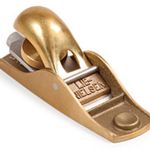
Lie-Nielsen No. 102 Low Angle Block Plane
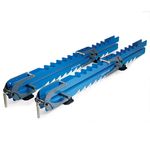
Rockler Deluxe Panel Clamp








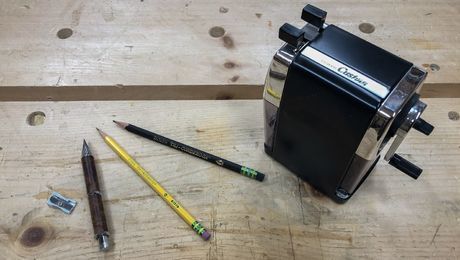
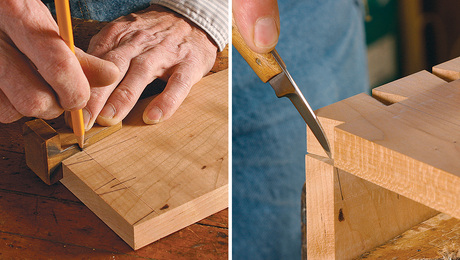
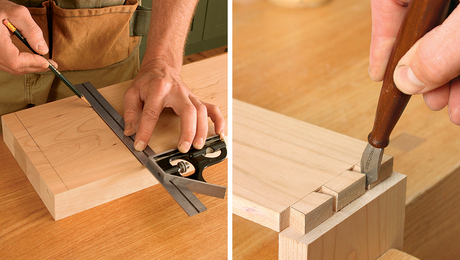
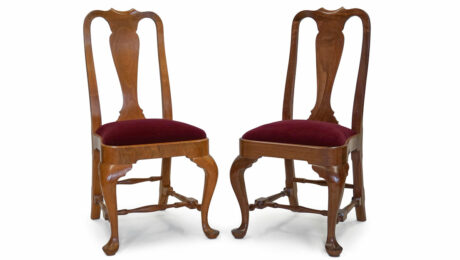
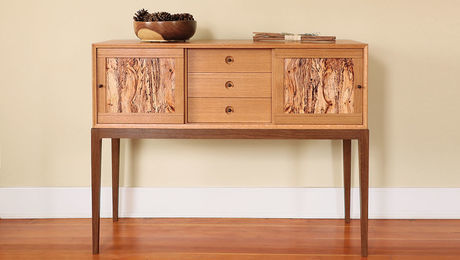



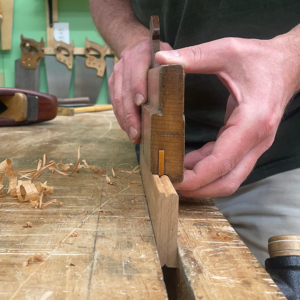







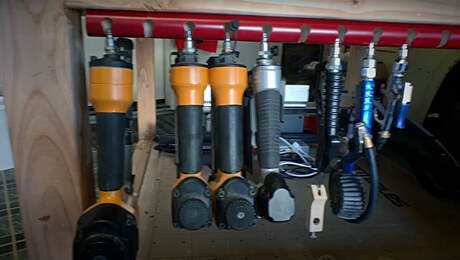








Comments
I've had mixed success with white colored pencils. Several were too waxy to mark well at all. I also tried a chalk pencil, but the tip wears down almost immediately when used on wood.
The recommendation for the pencil sharpener is my takeaway. Thanks Ben
TV's Phil
I've always just used a basic stick of chalk.
Works well, wipes off easily. Not the best for "fine" makings but as a general purpose marker, it's the only thing I use.
You missed two great options…both mechanical pencils:
pica dry makes white (and yellow and red I think) pencil “leads” for their mechanical system. The sleeve have a tipping sharpener when you want a very fine point—great for filling a little white into a knifed line. They are a little waxy and aren’t super, super bright. But the line doesn’t smudge or get fuzzy. And they are pretty tough wearing. They are perfect for layout after a first pass at milling from rough lumber.
My preference for marking precise jointer in dark wood is the Bohin mechanical pencil— it’s like a traditional mechanical pencil and so much thinner than the Pica maybe .9mm? Line is super crisp and bright! It’s thin point doesn’t ever need any sharpening, but is a little more fragile and best for marking joinery (after planing away milling marks). As a bonus it erases pretty easily —like a mechanical pencil.
For consideration:
One technique that I have used on walnut is to put blue tape down and then draw on the tape with a black pen. I used that to mark the location to cut a grove for maple inlay lines in walnut.
Thanks Ben. For general rough marking or carpenter triangles, I use a red wax marker based on taking a class for Megan Fitzpatrick. If I want a really fine line, like to fill a knife line, I use a 0.3 mm mechanical pencil based on one of the Lost Art Press Christmas gift recommendations close to a decade ago. I bought the Pica white leaded pencil as well but I don’t use it that much. I do appreciate what you have shown. May need to pick up another colored pencil or pen. My wife will think I’m crazy.
Log in or create an account to post a comment.
Sign up Log in